Posted by Patrick Weiler on 09-11-2003 12:39 PM:
Something Fishy
John has noted a lack of animal imagery in Moroccan weavings. I susptect that
some of this has to do with the restrictive limitations of flatweaves.
I have
a carpet in my collection with some rather fishy features:
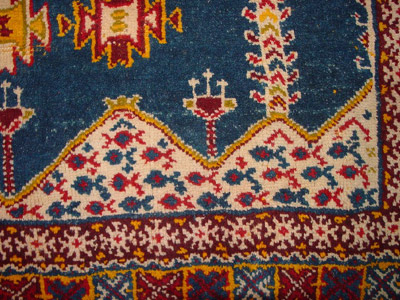
It is about 8x5 feet and has a
glorious orange weft, beautiful blues, great greens and riotous
reds.
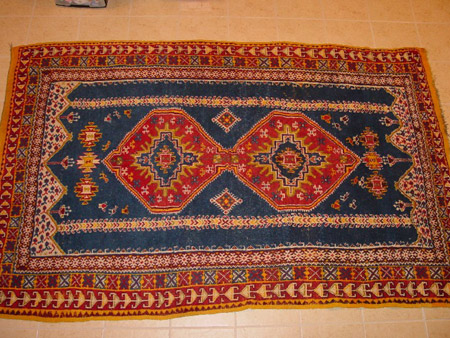
The
weaver also added several of her miniature camels into the field, and some
ewers, too:
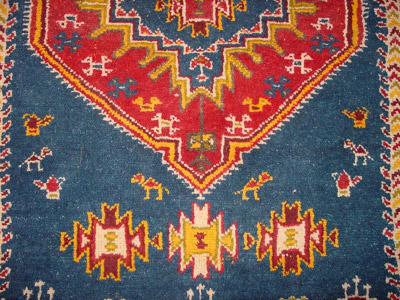
I
have no idea where the idea for the design of the carpet sprang from, nor do I
know where it was made. I just call it Moroccan.
You may notice the
similarity of the white symbols in the minor inner border with those in a NW
Persian? rug on the Show and Tell now. The outer border borrows from Persian
border designs, too. The fish in a mountainous sea almost are reminiscent of the
so-called "Portuguese" carpets. They, too, have white-ground outer field
sections portraying the ocean with fish and boats.
This all may indicate a
city produced rug, but I have not seen one quite like this in the limited
literature available to me.
Patrick Weiler
Posted by Vincent Keers on 09-11-2003 07:54 PM:
Hi Patrick,
I love it, I hate it, I love it.
"Good
morning.....It's going to be a fine day!"
Those E.T.'like heads popping
up: "Beep, beep..what's up?"
Thanks for showing,
Vincent

Posted by David R.E. Hunt on 09-11-2003 10:44 PM:
Design Origins- Arab and Berber
Patrick and All- It is my understanding that when those Turko-Arabs who
invaded what is now Morocco, they brought their design characteristics with
them, as demonstrated by the borders of your rug. Also, I think the field design
might be a deconstructed version of the column and arch design originating in
cairo and shared by the Turkish courts. Even today, while the overall character
of the moroccans may be that of Berber, those peoples constituting the majority
of urban inhabitants are of mixed Arab/Berber ethnic stock, and especially the
northern cities. The invading turko-Arabs marginalized the Berbers, and they
literally had to head for the hills to survive, yet there are a lot of hills in
Morocco, and they eventually reasserted themselves- yet the pure Berber ethnics
are still a rural and mountain people.
While this Berber kelim may sport some
of the worse dyes to ever grace the pages of Turkotek, my Turko-Arab-Berber wife
assures me that some of the figures in the border are talismans or amulets, the
significance of which she does not know, but that some weavers do- Dave
Posted by Patrick Weiler on 09-12-2003 01:16 AM:
I am Honored
David,
It is a rare pleasure to receive such accolades for a rug in my
humble collection -
The Worst Dyes to Ever Grace the Pages of
Turkotek.
I suspect the value of this humble weaving may now approach
the pinnacle of the market!
It is, however, a pile weaving - not a kilim,
with 3-to-5 wefts, white wool warp and an almost-gabbeh construction.
Your
wife's confirmation of the amuletic-nature of the border motifs brings tears of
ethnocentric tribalism to my heart.
The field design, with the curious
columns and several lamp-style appendages hanging from both ends of the field do
suggest a double-ended prayer-rug type of design.
The entire rug seems to be
an amalgam of motifs from various sources. Even the Turkmen ashik devices at
both ends of the field add to the collage of combinations of designs in this
curious carpet.
And the Orange color. It almost brings tears to the
eyes!
Thanks,
Patrick Weiler
Posted by Filiberto Boncompagni on 09-12-2003 04:05 AM:
Hi Patrick,
I think I can solve some of the mystery surrounding your
rug.
From Hali #94 _ "Moroccan carpets - From Rabat to the Atlas" page
76.
"RABAT CARPETS
…Such carpets were made in urban workshops and were
intended for the homes of the rich. (better you hide it in case of visit by
the tax-collector)
…Rabat carpets are clearly inspired by oriental
designs, especially those of urban Anatolia. It is probable, however, that they
were knotted by people of rural origin, or at least by people of strong Berber
tradition. Rabat carpets are situated at a confluence of two quite distinct
aesthetics. The stylized floral forms imported from Turkey had to be grafted
onto the more abstract geometric Moroccan tradition - not an easy union to
achieve. The results, which might have been uncomfortably hybrid, are often
highly original, and Rabat carpets are probably the most universally acclaimed
of all Moroccan weavings. Despite their popularity, little is known about the
exact conditions of their manufacture and development. Their date of origin is
especially problematic and the earliest examples are very rare
today."
The article shows two pictures of rather Anatolian looking rugs.
If you want I can scan and post them here.
Regards,
Filiberto
Posted by Patrick Weiler on 09-12-2003 10:14 AM:
Rabat Stew
Filiberto,
I would love to see the scans of Rabat carpets you refer
to.
Your description of Rabat carpets certainly pertains to this one, a mix
of designs from Berber, Anatolian and Persian (and Turkmen) traditions.
At
least they retained their love of the almost-vulgar  orange.
orange.
Compared to the
restrained-yet-lurid splotches one sees in contemporaneous Caucasian carpets,
these Moroccan carpets revel in it.

Patrick Weiler
Posted by Filiberto Boncompagni on 09-12-2003 11:14 AM:
Sure.
First one, early 19th century, 1.61 x 4.00 m (5’3" x
13’1")
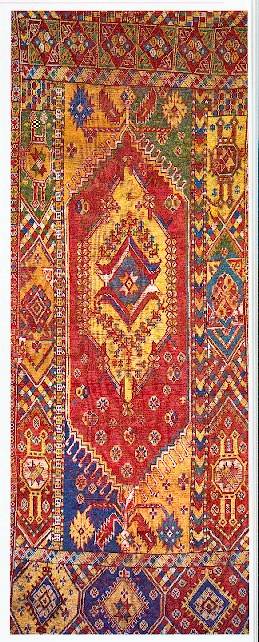
second
one, early 19th century 1.65 x 3.38 (5’5" x 11’1")
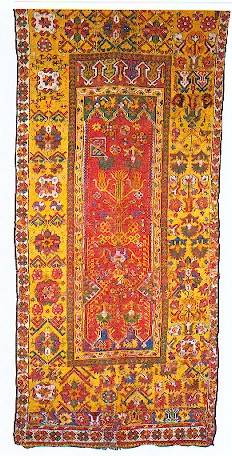
Regards,
Filiberto
Posted by David R.E. Hunt on 09-12-2003 05:27 PM:
Oops!
Dear Patrick , Filiberto, and all- Actually, I was refering to a photo of my
rug which I e-mailed to Steve last night- perhaps he is indisposed- I think that
your rug is quite nice Patrick- I'll mail it to Filiberto- Dave
Posted by Vincent Keers on 09-12-2003 08:28 PM:
Orange?
Hi Patrick,
What orange?
I see red, yellow etc.
Orange?
What's wrong with orange?
I love orange!
It's a
color.
Have a good look at 17'th century court rugs.
Purple, orange, pink.
I've seen it. Exposed in a dark church........but I saw it....or maybe it was
the short skirt and orange panties that.....oohh never mind.
So, whatever
you say...I like your rug
Best regards,
Vincent
Posted by David R.E. Hunt on 09-12-2003 08:42 PM:
Into the Amalgam
Patrick, Filiberto, and All- Could these needlepoint works represent the
missing influence exerted upon the design repetoir of Rabat carpets? My wife
refers to these as "Tars Asab" or "Made with Counting" and refers to the way
that they are executed by the seamstress. The northern portion of the country
are famous for these, or at least something simular, although it is my
understanding that they are usually executed in blue thread instead of green as
these, which are from the Marakkech area. Also, I have seen (actually have a
photo, but no time to scan) these pyramid shaped devices executed upon a strip
and suspended apex down upon a wall as decoration for a bridal shower- ladies
only of course.- Dave
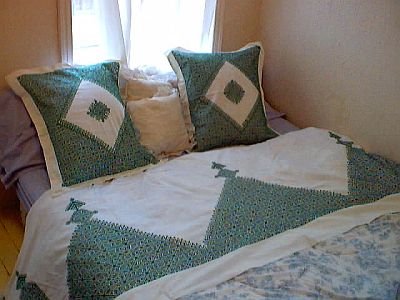
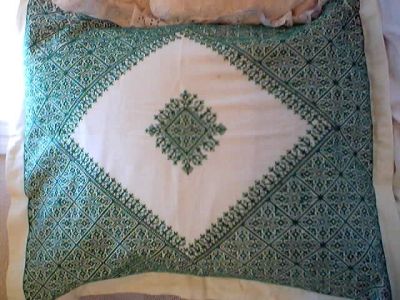
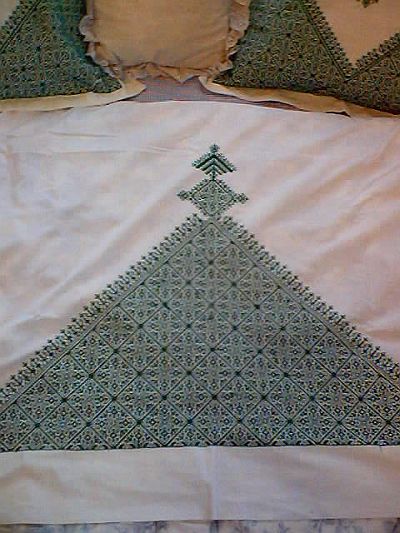
Posted by Filiberto Boncompagni on 09-13-2003 03:03 AM:
And this is David's rug.
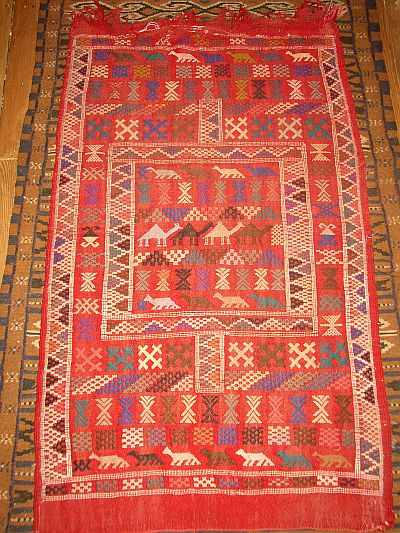
Posted by David R.E. Hunt on 09-29-2003 05:12 PM:
wedding Customs
All- I was able to find my photo of the bridal shower, showing some of these
embroideries in use. In this case the apex is not inverted, but then this is not
the same said piece, I think...
I've also thrown in a photo of my wife's
Henna and a picture of her in the bridal litter- for those more familiar with
these customs, they might further evidence as to the origins of the Berber
people- Dave
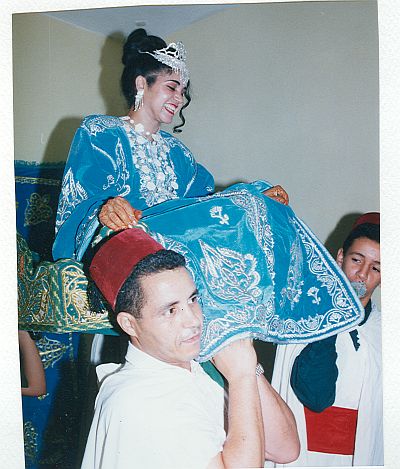
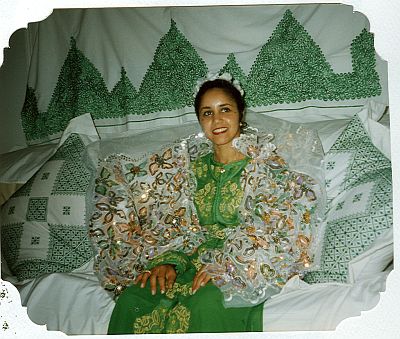
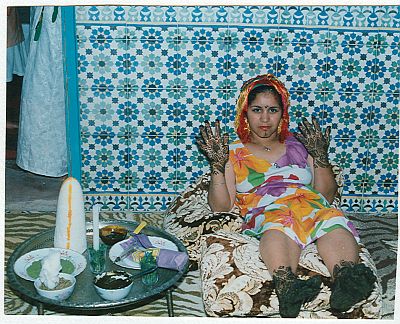




 orange.
orange. 









